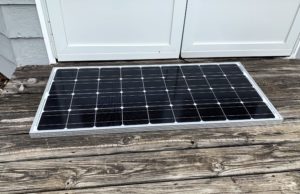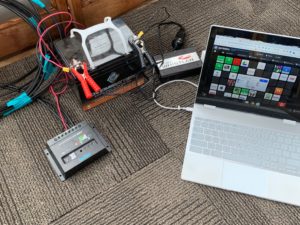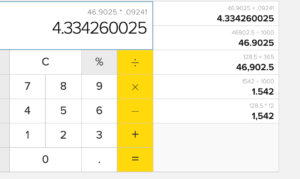A few years ago I purchased some basic equipment that would allow me to investigate solar energy. I bought a solar panel, a charge controller, a battery, and an inverter for changing the DC stored in a battery to the AC required for many devices. Finding a system of this type on Amazon was easy. It is my impression that such systems are commonly sold to individuals wanting to add a power source to campers for situations in which campers want a setup that allows them to set up a trailor without hookups. Folks must find all kinds of ways to use a source for electricity that most of us do not consider.
My plan was to set this system up at our lake place and just explore what I could do with the “free” electricity I could generate. I got the system to work, but did not really do much with it because I could not find a good location to permanently position the panel. The trees and my own hesitancy to mount the panel on our two-story tall roof limited by progress. I put the equipment out of sight and pretty much forgot about my project.
I did not lose interest in solar energy. We got as far as having an installer come to our home. He took a look at our energy bill and the usable space on our roof. He estimated they could place 7 panels on our roof, but because our consumption of electricity was low it would not be a financial advantage. We heat and cook with gas and we spend a lot of time in other places so we don’t buy much electricity. We decided to go ahead anyway as a matter of principle, but he then said we should first replace our shingles because once you pay for the installation of the panels you don’t want to pay to have them removed and then reinstalled when you upgrade to new shingles. We decided to put off the solar panels for a few years.
A week or so ago, I came up with a way to try my project again. We have a gazebo outside our home. We don’t use it a lot, but it offers some interesting opportunities. I decided I could just lay the solar panel on the small back deck of the gazebo, run the cables through the opening between the French doors into the gazebo, and position the other equipment inside. No climbing on a roof and no drilling holes through walls. No new costs. This arrangement would not be permanent, but it would do for a couple of months or so.
I wish I had some way to measure the amount of electricity I generated. Your house obviously as a meter that quantifies your consumption. There must be some way to do this on a smaller scale, but there is a limit to how much stuff I want to purchase at this point. I decided my goal would be to see if I could keep my devices charged using “free” solar energy. This is what researchers in my profession might call a “proof of concept project”.
I searched online to see if could find a way to estimate just how much my devices might use. I found a source estimating the amount of electricity and the related cost of keeping an iPhone, iPad, and laptop going. I looked up the cost to me for electricity and recalculated what my cost would be using the approach outlined in this source. According to my calculations, I pay about $4.33 a year to keep my laptop charged. Clearly with my battery, panel, and other equipment, I am not committed to a money making deal here. Just to keep a battery capable of storing electricity going over multiple years, I would be spending far more on equipment than I make on the electricity I use.
Still, I think this has been and will continue to be a useful exercise. I cannot help imagine how a classroom teacher or school might duplicate this project and use it with students. The needed equipment is certainly inexpensive enough if viewed at this level. What if you did the same project and used it to charge the laptops for 25 students? What might you learn about energy production? What data could you collect and analyze? Terms such as ohm, watt, and inverter would have meaning.
28 total views



You must be logged in to post a comment.